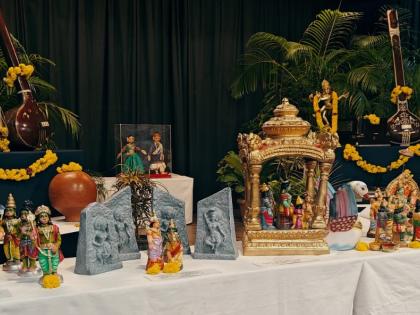Karnataka Shines During Navratri with Gombe Habba: The Festival of Dolls
By Anubha Jain | Updated: October 5, 2024 12:18 IST2024-10-05T12:16:20+5:302024-10-05T12:18:11+5:30
The celebration of Dussehra and Navratri's distinctive expressions in South India is illustrated by regional traditions and narratives. One ...

Karnataka Shines During Navratri with Gombe Habba: The Festival of Dolls
The celebration of Dussehra and Navratri's distinctive expressions in South India is illustrated by regional traditions and narratives. One such unique expression of the festival is the arrangement of dolls. Enumerating the tales of Indian history and Puranas through dolls is a time-tested tradition known as Gombe Habba (festival of dolls) in Karnataka. Every year celebrating the tradition of Dussehra dolls or Gombe Habba takes centre stage in this festival time. Showcasing Indian art and culture and keeping this tradition alive with an array of doll-narrating themes can be commonly seen in the homes of Bengaluru and the entire Karnataka during this time of Sharada Navaratri. The Festival of Dolls involves collecting a wide range of wooden and clay dolls and presenting them on a multi-stage platform.The doll display focuses on tales from Ramayana, Mahabharata, Srimad Bhagvatha Gita, and stories from Hindu Puranas besides highlighting pilgrimage centers like Char Dham, Tirupati, Kailash Mansarovar, etc. People also display Puri’s famous Jagannath Rath Yatra, and Tirupati Brahmotsavam through these dolls.
In this vein, the mythological epic Ramayana demonstration through unique doll arrangement can be witnessed in Bengaluru’s Bhartiya Vidya Bhawan. Around 2500 dolls are placed to narrate 10 themes from Ramayana. The multiple facets of this epic are depicted through a colourful array of dolls. The thematic presentation offers varied perspectives of Ramayana- be it Lord Rama’s valour, Sita Ma’s abiding fondness for Lord Rama, Hanuman’s selfless service for Ma Sita and Lord Rama, and the unconditional loyalty of many others. The doll festival begins on the very first day of Navaratri. During these nine days, the dolls are not rearranged or even touched for they are believed to have come to life now. Every morning the dolls along with the kalasha are worshipped with flowers, prayers, and prasada. On the day of Vijayadashami, a final puja is offered to the dolls. The Gombe Habba ends with moving the kalasha and it symbolizes that one is bidding goodbye to the Devi. The dolls are put to sleep only to be awakened during the next Navaratri.
Gombe Habba in Karnataka is characterized by Pattada Gombe – a pair of dolls made from wood, clay and dressed as the King and the Queen. During the times of the Vijayanagara Empire, this tradition has been continued by the Mysuru Wodeyars. A pair of Pattada Gombe is gifted to a newly married daughter by her parents and is believed that the Pattada Gombe are a married couple who have come to the girl’s maternal home during the Navaratri.There are a few stories adjoined to explain the relevance of doll display. Some people believe that the dolls come to life during the nine nights of the festival and they need to be put back to sleep on the night of Vijayadasham or Dussehra. As per another belief, these dolls represent the goddess army. Yet another explanation is that the dolls are Devi's energy in her fight against evil. But the common belief behind the doll arrangement is inviting the Divine Goddess home through the puja of Kalasha on these nine nights.
It is pertinent to mention that these dolls are passed on from one generation to another. The bubble-headed, and colourful dolls convey meaningful messages and life lessons rooted in our Puranas and cultural heritage. The doll festival is an opportunity to celebrate the skill of our country's craftsmanship artisans and showcase the ancient tradition of doll making in India.
Open in app